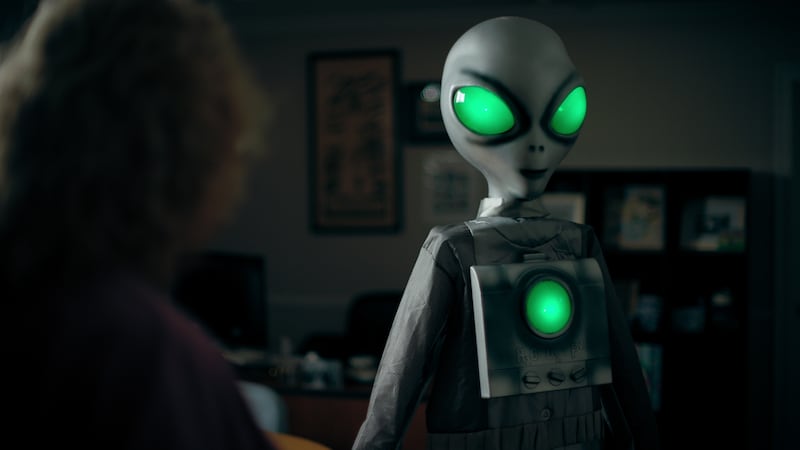The 18th-century Scottish economist and wig aficionado Adam Smith once contemplated the specialised craftspeople involved in the optimal creation of a single pin. The wealth of nations is built on specialisation, he concluded, feeling quite proud of himself, and hundreds of years of classical economists and economic planners took him at his wiggy word. Flash-forward to 21st-century late capitalism and I’m watching a Netflix gameshow called Is It Cake?, which involves “the most insanely talented hyper-realistic cake artists on the planet.” That’s a job now.
“We’re f**ked,” I say to my wife. “Absolutely f**ked. Thanks a bunch, Adam Smith*.”
(*Full disclosure: I probably don’t understand the work of Adam Smith.)
Yes, I’m taking the fact that “hyper-realistic cake artists” are so plentiful we can populate a popular gameshow with them as a sign that the jig is up for the human race. Who will want to do anything else once they learn that hyper-realistic cake artistry is an option?
Have your say: Have childcare costs impacted your employment?
‘My 17-year-old says the panic just takes him over and sometimes he can’t go into school’
Have your say: Are hot school meals too ultra-processed or a nutritious boost for children?
Young parents: ‘A lot of them would suffer social anxiety and isolation’
Here are some sentences I worry I will hear later in my life:
- “Is there a doctor in the house?”
- “Is there an engineer here who might stand over the structural soundness of this bridge?”
- “Is there someone on board who might be able to fly this fast-descending plane?”
- All followed by: “I guess this hyper-realistic cake artist will have to do it.”
When things go to hell, if there are only three spaces in your bomb shelter and a doctor, a farmer, a hypochondriacal television columnist and “a hyper-realistic cake artist” are all begging to be let in, heed me now: in the interests of conserving civilisation take the doctor, the farmer and the hypochondriacal television columnist (so the doctor can practise) and leave the hyper-realistic cake artist to their fate.
And, yes, I know all your children probably want to be “hyper-realistic cake artists” too (thanks to Is It Cake?) and they’re probably at cake-art college because, like a fool, you encouraged them to follow their dreams instead of doing business studies and Mandarin. I’d also suggest leaving them outside the shelter. It’s over for them. We need to start again without dreams of foppish cakery.
Look, I get why Is it Cake? exists. For millennia philosophers have asked “Why does something exist instead of nothing?”, “Why does God permit war?”, “What is consciousness?” and, of course, “Is it cake?” But that last question was pretty solidly answered in the very first episode of Is It Cake? (The answer: It is sometimes cake.) Yet for some reason the programme-makers persevere with their experiment.
Here’s how it goes. In each episode a wildly enthusiastic man named Mikey Day emerges on a revolving custom-made set. Much of this set is, we now know, constructed from the finest cake. However, we the viewers do not know which bits are cake and which conform to the normal rules of the universe as outlined by Newton and Heisenberg etc. Mikey Day then challenges a gathering of eight hyper-realistic cake artists, who all seem like perfectly pleasant people, to identify what items among his set of everyday stuff are, in fact, cake.
Mikey demonstrates the truth by stabbing objects with a cleaver. Do not show your worst child this programme! Your worst child already suspects everything is cake, and I’m pretty sure he owns a cleaver. And so we witness Mikey carve carefully through things and then eat clumps of the objects that turn out to be cake. He is the only person I have seen both figuratively and literally chewing the scenery. “It is cake!” he frequently cries, much like Charlton Heston cries “Soylent Green is people!” I presume that after each episode Mikey runs through the streets hooting in this manner.
In the first episode of the third series, Mikey Day slices through, then chomps upon a decorative beer stein, an armchair, some pool balls and a lamp with a bright bulb in it. “Does cake light up?” he asks rhetorically, for this cake clearly lights up, but it is unclear how the science of this works, because there are no electricians now, just hyper-realistic cake artists. I can only assume cake conducts electricity.
The four contestants who prove to be best at cake detection are then called on to create their own cake lies. “I want to show my kids if you believe in yourself you can achieve whatever you want to do,” says one of them, but in a manner that suggests that if her kids wanted to be accountants or data analysts, and not hyper-realistic cake artists, she might disown them.
The four cake artists make: a bag of flower, a decorated tiki mug, a roller skate and a dartboard, all of which are, in fact, cake. Then these are placed alongside noncake versions of the same objects, and three guest comedians must choose which is cake. It’s frequently surprising which ordinary-looking object is, in fact, a Baudrillardian simulacrumb. And it’s compelling television, to be fair. Midway through the show, having three comedians determine which things are cake and which things are not cake begins to look like a reasonable system of government. By the end of the episode I am all in, convinced that the world is filled with cakey deceptions and only the hyper-realistic cake artists can save us. Looking around my sittingroom, I wonder which of my gimcracks and gewgaws might have been replaced with cake, by the CIA, probably. What I need is a small cleaver.

One of the other most popular Netflix shows in Ireland this week is, apparently, Files of the Unexplained, a show in which “unexplained” phenomena are investigated. If reality shows such as Drive to Survive and Full Swing are what Netflix has instead of sport, I’m pretty confident programmes such as Files of the Unexplained are what we’ll soon be getting instead of “the news”. It forgoes things such as evidence and just has a bunch of people tell us what they believe happened to them while eerie music plays. The counterargument is me telling you that those things didn’t happen. (If you put eerie music under me saying that, it counts as an investigation.)
Nationwide (RTÉ One) is a bit more old-school in its journalistic methods. It’s a programme in which Anne Cassin, in a nice coat, roams the blighted outlands bringing hope from the old world (Montrose), much like Kevin Costner did in The Postman. Nationwide is a jewel in RTÉ’s crown, to be honest, consistently covering interesting local stories and fascinating local humans in a manner that probably won’t happen on Netflix unless those humans believe they were abducted or are secretly cake. (Only one way to check!)
Monday’s episode sees Cassin wander with the designer Trevor Finnegan as he documents classic smalltown-shop signage and talk to the artist Laura Earley about Roscommon’s mosaic-shopfront tradition. It’s lovely. At no point does anyone start gnawing at these beautifully crafted facades while ranting about cake. But mark my word, that’s the future.






